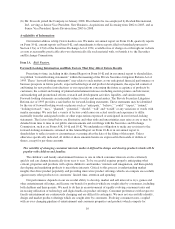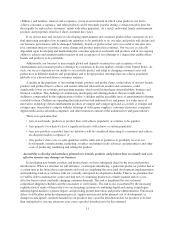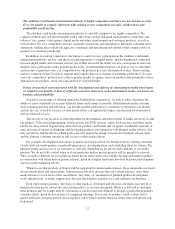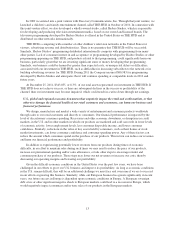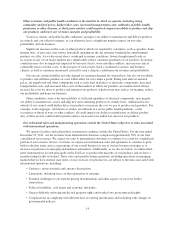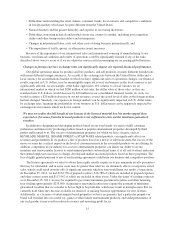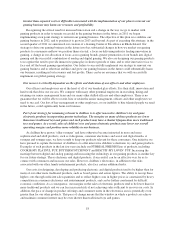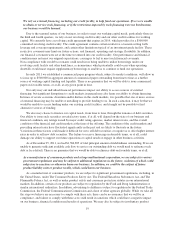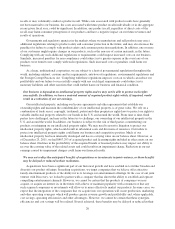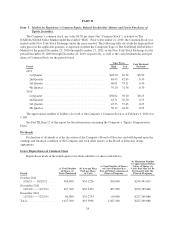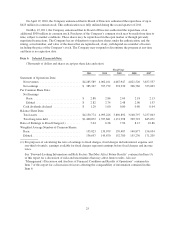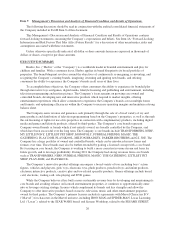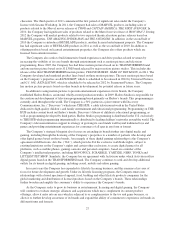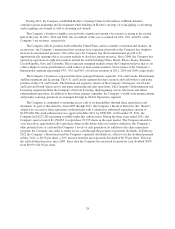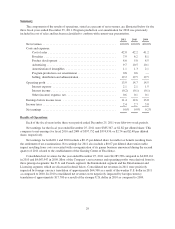Hasbro 2011 Annual Report Download - page 29
Download and view the complete annual report
Please find page 29 of the 2011 Hasbro annual report below. You can navigate through the pages in the report by either clicking on the pages listed below, or by using the keyword search tool below to find specific information within the annual report.recalls or may voluntarily conduct a product recall. While costs associated with product recalls have generally
not been material to our business, the costs associated with future product recalls individually or in the aggregate
in any given fiscal year, could be significant. In addition, any product recall, regardless of direct costs of the
recall, may harm consumer perceptions of our products and have a negative impact on our future revenues and
results of operations.
Governments and regulatory agencies in the markets where we manufacture and sell products may enact
additional regulations relating to product safety and consumer protection in the future, and may also increase the
penalties for failure to comply with product safety and consumer protection regulations. In addition, one or more
of our customers might require changes in our products, such as the non-use of certain materials, in the future.
Complying with any such additional regulations or requirements could impose increased costs on our business.
Similarly, increased penalties for non-compliance could subject us to greater expense in the event any of our
products were found to not comply with such regulations. Such increased costs or penalties could harm our
business.
As a large, multinational corporation, we are subject to a host of governmental regulations throughout the
world, including antitrust, customs and tax requirements, anti-boycott regulations, environmental regulations and
the Foreign Corrupt Practices Act. Complying with these regulations imposes costs on us which can reduce our
profitability and our failure to successfully comply with any such legal requirements could subject us to
monetary liabilities and other sanctions that could further harm our business and financial condition.
Our business is dependent on intellectual property rights and we may not be able to protect such rights
successfully. In addition, we have a material amount of acquired product rights which, if impaired, would
result in a reduction of our net earnings.
Our intellectual property, including our license agreements and other agreements that establish our
ownership rights and maintain the confidentiality of our intellectual property, is of great value. We rely on a
combination of trade secret, copyright, trademark, patent and other proprietary rights laws to protect our rights to
valuable intellectual property related to our brands in the U.S. and around the world. From time to time, third
parties have challenged, and may in the future try to challenge, our ownership of our intellectual property in the
U.S. and around the world. In addition, our business is subject to the risk of third parties counterfeiting our
products or infringing on our intellectual property rights. We may need to resort to litigation to protect our
intellectual property rights, which could result in substantial costs and diversion of resources. Our failure to
protect our intellectual property rights could harm our business and competitive position. Much of our
intellectual property has been internally developed and has no carrying value on our balance sheet. However, as
of December 25, 2011, we had $467,293 of acquired product and licensing rights included in other assets on our
balance sheet. Declines in the profitability of the acquired brands or licensed products may impact our ability to
recover the carrying value of the related assets and could result in an impairment charge. Reduction in our net
earnings caused by impairment charges could harm our financial results.
We may not realize the anticipated benefits of acquisitions or investments in joint ventures, or those benefits
may be delayed or reduced in their realization.
Acquisitions have been a significant part of our historical growth and have enabled us to further broaden and
diversify our product offerings. In making acquisitions, we target companies that we believe offer attractive
family entertainment products or the ability for us to leverage our entertainment offerings. In the case of our joint
venture with Discovery, we looked to partner with a company that has shown the ability to establish and operate
compelling entertainment channels. However, we cannot be certain that the products of companies we may
acquire, or acquire an interest in, in the future will achieve or maintain popularity with consumers or that any
such acquired companies or investments will allow us to more effectively market our products. In some cases, we
expect that the integration of the companies that we acquire into our operations will create production, marketing
and other operating synergies which will produce greater revenue growth and profitability and, where applicable,
cost savings, operating efficiencies and other advantages. However, we cannot be certain that these synergies,
efficiencies and cost savings will be realized. Even if achieved, these benefits may be delayed or reduced in their
20


